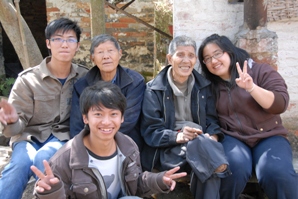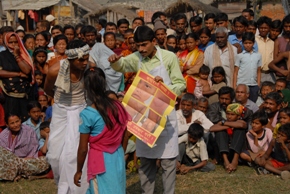Leprosy in Our Time – Medical and Social Challenges
Everyone has a role to play in tackling stigma

The human rights dimension
While medical efforts to conquer leprosy have made tremendous progress in recent decades, it is fair to say that efforts to tackle the disease’s social aspects have lagged behind. Due to the general public’s ignorance, misunderstanding, indifference or fear, millions of persons cured of leprosy and even their families still suffer from the stigma associated with the disease.
At different times and places, the way persons affected by leprosy and their families have been treated by governments, communities, schools, companies, hospitals and other organizations, including religious institutions, has constituted a serious violation of their human rights, stripping them of their dignity in the process. Enforced isolation, limited or no access to social services, discrimination in the job market, obstacles in the way of getting an education, and problems finding a place to live are just some of the ways in which persons affected by leprosy have suffered.

Creating an inclusive society
Over the centuries, the stigma visited upon persons affected by leprosy represents one of the most pervasive forms of social injustice suffered by any one group of human beings.
Article 1 of the Universal Declaration of Human Rights states: “All human beings are born free and equal in dignity and rights.” This includes every person affected by leprosy—yet legal, social and economic discrimination persists.
For society to live up to Article 1, it is essential that the inherent rights of persons affected by leprosy, embodied in the Declaration, are acknowledged.
Putting this age-old issue to rest will help to realize a society in which every human being is able to enjoy his or her fundamental human rights, and in which the dignity of every human being is recognized.
Achieving a UN resolution
In September 2010, the UN Human Rights Council unanimously adopted a resolution on elimination of discrimination against persons affected by leprosy and their family members, together with accompanying principles and guidelines. Three months later, the resolution was adopted at the UN General Assembly. This historic achievement for persons affected by leprosy was the culmination of a process initiated by Yohei Sasakawa, then president and now chairman of The Nippon Foundation, in July 2003 (see chart).
Turning words into deeds
Between 2012 and 2014, The Nippon Foundation is organizing a series of five regional symposia (in the Americas, Asia, Africa, the Middle East and Europe) to promote awareness of the UN resolution and explore how the principles and guidelines can be implemented. The symposia bring together government officials, organizations of persons affected by leprosy, NGOs, representatives of the WHO, human rights experts and other stakeholders. In parallel with these symposia, an International Working Group consisting of persons affected by leprosy, human rights experts and NGOs has been established to discuss a sustainable mechanism to follow up on the UN resolution and the principles and guidelines. Discussions are under way to formulate a model plan of action and mechanism to monitor actions taken by stakeholders.
The road to a UN resolution
July 2003
Yohei Sasakawa visited the Office of the High Commissioner for Human Rights in Geneva to draw attention to the problems faced by persons affected by leprosy.

August 2003
The Nippon Foundation made an official approach to the UN Sub-Commission on the Promotion and Protection of Human Rights. This was the first time that the human rights concerns of persons affected by leprosy had been brought before the UN.
August 2005
The UN Commission on Human Rights (UNCHR) adopted a resolution to push governments and UN bodies to improve the situation of persons affected by leprosy.
March 2007
The Japanese Government took a request for action to the UN Human Rights Council (the successor to the UNCHR) on the issue of leprosy and human rights.
June 2008
A resolution titled “Elimination of discrimination against persons affected by leprosy and their family members” was submitted by 59 countries under the leadership of the Japanese Government at the 8th meeting of the UN Human Rights Council (UNHRC). The resolution was adopted on June 18. On the basis of this resolution, the UNHRC Advisory Committee started to draw up principles and guidelines for ending discrimination.
September 2010
A resolution to eliminate discrimination against persons affected by leprosy, together with principles and guidelines, was unanimously adopted at the 15th Session of the UNHRC.
December 2010
The United Nations General Assembly adopted the resolution and its set of principles and guidelines without a vote on December 21.
Principles and Guidelines: Key Points
Principles
Persons affected by leprosy and their family members should be treated as people with dignity and are entitled to all human rights and fundamental freedoms.
Guidelines
States should ensure:
- no discrimination on the grounds of leprosy
- equal protection and equal benefit of the law
- special attention to rights of women, children and other vulnerable groups
- reunification of families
- access to education
- employment and vocational training opportunities
- full inclusion and participation in the community
- voting rights
- removal of discriminatory language
- access to public places
- same standard of healthcare enjoyed by persons with other diseases
- adequate standard of living
- formulation of policies and plans of action to promote respect for rights and dignity.
-
 Resolution adopted by the United Nations General Assembly on Elimination of discrimination against persons affected by leprosy and their family members (PDF/100KB)
Resolution adopted by the United Nations General Assembly on Elimination of discrimination against persons affected by leprosy and their family members (PDF/100KB)
-
 “Draft set of principles and guidelines for the elimination of discrimination against persons affected by leprosy and their family members” (PDF/53KB)
“Draft set of principles and guidelines for the elimination of discrimination against persons affected by leprosy and their family members” (PDF/53KB)
(On the United Nations’ Human Rights Council Website)



